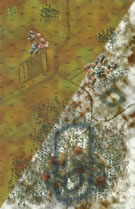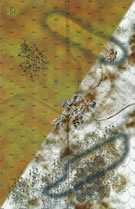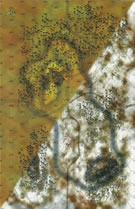|
All In Spearhead Division #4 |
||
|---|---|---|
| (Defender) Germany | vs | United States (Attacker) |
| Formations Involved | ||
|---|---|---|
| Germany |  |
12th Infantry Division |
| Germany |  |
9th Panzer Division |
| United States |  |
3rd "Spearhead" Armored Division |

|
| Overall Rating, 2 votes |
|---|
|
4.5
|
| Scenario Rank: --- of 964 |
| Parent Game | Spearhead Division |
|---|---|
| Historicity | Historical |
| Date | 1944-09-17 |
| Start Time | 09:00 |
| Turn Count | 20 |
| Visibility | Day |
| Counters | 148 |
| Net Morale | 0 |
| Net Initiative | 1 |
| Maps | 4: 22, 23, 24, 25 |
| Layout Dimensions | 86 x 56 cm 34 x 22 in |
| Play Bounty | 186 |
| AAR Bounty | 167 |
| Total Plays | 2 |
| Total AARs | 1 |
| Battle Types |
|---|
| Delaying Action |
| Exit the Battle Area |
| Hill Control |
| Inflict Enemy Casualties |
| Urban Assault |
| Entrenchment Control |
| Conditions |
|---|
| Anti-infantry Wire |
| Entrenchments |
| Minefields |
| Off-board Artillery |
| Randomly-drawn Aircraft |
| Reinforcements |
| Severe Weather |
| Smoke |
| Scenario Requirements & Playability | |
|---|---|
| Elsenborn Ridge | Maps + Counters |
| Spearhead Division | Base Game |
| Introduction |
|---|
|
With Task Force Lovelady bogged down, Third Armored Division’s staff sent Task Force Mills to take the high ground near Duffenter. This would allow American forward observers an unobstructed view of Stolberg from the east. Already short of infantry due to their tank-heavy organization, the Spearhead Division had been worn down to about half of its armored strength over four days of heavy fighting. Sending two task forces into combat meant that CCB had little reserve if things went wrong. |
| Conclusion |
|---|
|
The dawn attack against the infantry of CCA started things off badly for the Americans, but the division staff ordered them forward anyway. Soon both Task Forces were under heavy fire and unable to advance. Lieutenant Colonel Samuel Hogan gathered up what few remaining men and machines he could find and tried to advance on Lovelady's right. It made no difference as the American forward progress was agonizingly slow. While all this was going on a probing attack by the Wild Buffaloes also failed to advance. The Germans reorganized themselves in some woods and managed to surround Company E from the Second Battalion of the 36th Armored Infantry Regiment and scattered those they didn't capture. Only four men made it back to friendly lines during the fighting. The Germans still controlled Weissenberg and most of the high ground at the end of the day. Each side suffered enormous casualties during the fighting and both were eager to end aggressive action. |
| AFV Rules Pertaining to this Scenario's Order of Battle |
|---|
|
| 3 Errata Items | |
|---|---|

|
The reduced direct fire value of the Heer HMG became 5-5 starting with Fall of France. (plloyd1010
on 2015 Jul 31)
|

|
The morale and combat modifiers of German Sergeant #1614 should be "0", not "8". (Shad
on 2010 Dec 15)
|

|
The movement allowance on the counters in Airborne is misprinted. It should be "3." (rerathbun
on 2012 Jan 30)
|
| A Knock-Down, Drag-Out Fight |
|---|
|
The US 3rd Armored attempts to break through the West Wall, take some towns and forge a breakthrough. It’s a tall order with bad weather and a bunch of German reinforcements standing in the way. This is a big battle using all four Elsenborn maps. The Germans start with thin forces, many of them half strength units holding entrenchments scattered here and there. The Americans come up from the south and start clearing the frontline trenches, methodically using artillery, direct fire from tanks, infantry assaults and the occasional air strike to clear them out. The US eventually took six of the eight entrenchments in the game. The German reinforcements arrived on the first eligible turn on the west edge and started moving east-southeast. They moved deliberately but held together, and eventually fell on the US left flank just as they were finishing off a trench and preparing to attack a village on board 22. They hit the US line hard and stalled them out. German armor pinned the American mechanized units down but the GIs scored a few hits, with the big prize being the Jagpanzer, jumped by a M4 Jumbo from the woods. Eventually the two sides slugged it out on the hill on board 24, with the Germans stopping the US cold atop the hill. Finally the Americans went back to what they do best, pounding the opposition with copious amounts of artillery. Disruptions and demoralizations piled up and in the final turns the Germans started pulling back. However the GIs were too scattered and weakened to press ahead. Both sides absorbed a lot of punishment—the Germans lost 26 steps and the Americans 29. The US cleared the aforementioned trenches and the towns on the southern maps, but the Germans held all of the northern towns and prevented a breakthrough. Final score 53-44 Germany. This was a rough, intense engagement that wasn’t decided until the final few turns. The German counterattack held the line but at great cost. Game wise there was a lot going on and the victory conditions are quite demanding for the US. As long as a German player keeps the field covered by the tanks and AT guns, and doesn’t let the infantry get sucked into too many attritional battles he should have the edge. |
| 0 Comments |

 SpDv003
SpDv003 















































